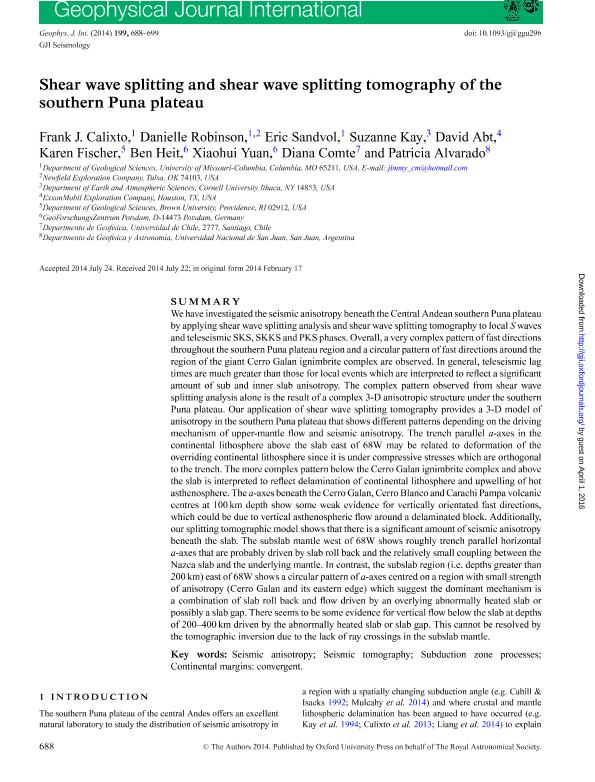Artículo
Shear wave splitting and shear wave splitting tomography of the southern Puna plateau
Calixto, Frank J.; Robinson, Danielle; Sandvol, Eric; Kay, Suzanne; Abt, David; Fischer, Karen; Heit, Ben; Yuan, Xiaohui; Comte, Diana; Alvarado, Patricia Monica

Fecha de publicación:
11/2014
Editorial:
Wiley
Revista:
Geophysical Journal International
ISSN:
0956-540X
Idioma:
Inglés
Tipo de recurso:
Artículo publicado
Clasificación temática:
Resumen
We have investigated the seismic anisotropy beneath the Central Andean southern Puna plateau by applying shear wave splitting analysis and shear wave splitting tomography to local S waves and teleseismic SKS, SKKS and PKS phases. Overall, a very complex pattern of fast directions throughout the southern Puna plateau region and a circular pattern of fast directions around the region of the giant Cerro Galan ignimbrite complex are observed. In general, teleseismic lag times are much greater than those for local events which are interpreted to reflect a significant amount of sub and inner slab anisotropy. The complex pattern observed from shear wave splitting analysis alone is the result of a complex 3-D anisotropic structure under the southern Puna plateau. Our application of shear wave splitting tomography provides a 3-D model of anisotropy in the southern Puna plateau that shows different patterns depending on the driving mechanism of upper-mantle flow and seismic anisotropy. The trench parallel a-axes in the continental lithosphere above the slab east of 68W may be related to deformation of the overriding continental lithosphere since it is under compressive stresses which are orthogonal to the trench. The more complex pattern below the Cerro Galan ignimbrite complex and above the slab is interpreted to reflect delamination of continental lithosphere and upwelling of hot asthenosphere. The a-axes beneath the Cerro Galan, Cerro Blanco and Carachi Pampa volcanic centres at 100 km depth show some weak evidence for vertically orientated fast directions, which could be due to vertical asthenospheric flow around a delaminated block. Additionally, our splitting tomographic model shows that there is a significant amount of seismic anisotropy beneath the slab. The subslab mantle west of 68W shows roughly trench parallel horizontal a-axes that are probably driven by slab roll back and the relatively small coupling between the Nazca slab and the underlying mantle. In contrast, the subslab region (i.e. depths greater than 200 km) east of 68W shows a circular pattern of a-axes centred on a region with small strength of anisotropy (Cerro Galan and its eastern edge) which suggest the dominant mechanism is a combination of slab roll back and flow driven by an overlying abnormally heated slab or possibly a slab gap. There seems to be some evidence for vertical flow below the slab at depths of 200–400 km driven by the abnormally heated slab or slab gap. This cannot be resolved by the tomographic inversion due to the lack of ray crossings in the subslab mantle.
Palabras clave:
Seismic Anisotropy
,
Seismic Tomography
,
Continental Margins
,
Subduction Zone
Archivos asociados
Licencia
Identificadores
Colecciones
Articulos(CIGEOBIO)
Articulos de CENTRO DE INVESTIGACIONES DE LA GEOSFERA Y BIOSFERA
Articulos de CENTRO DE INVESTIGACIONES DE LA GEOSFERA Y BIOSFERA
Articulos(SEDE CENTRAL)
Articulos de SEDE CENTRAL
Articulos de SEDE CENTRAL
Citación
Calixto, Frank J.; Robinson, Danielle; Sandvol, Eric; Kay, Suzanne; Abt, David; et al.; Shear wave splitting and shear wave splitting tomography of the southern Puna plateau; Wiley; Geophysical Journal International; 199; 2; 11-2014; 688-699
Compartir
Altmétricas



